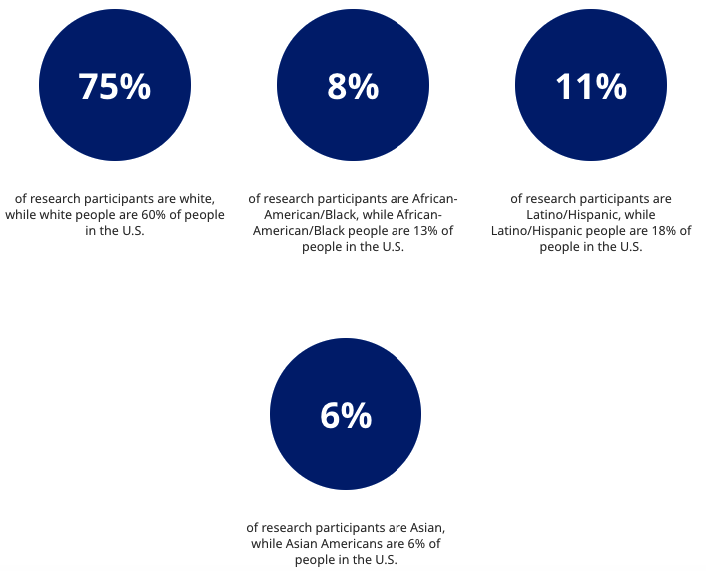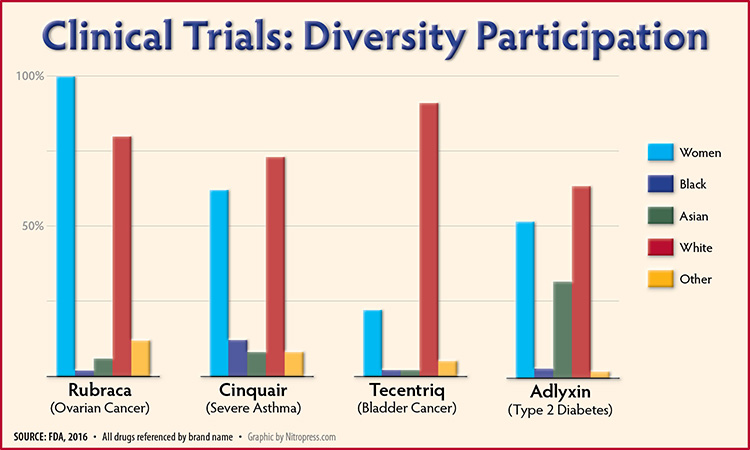The National Black Breast Cancer Fund ( NBBCF), NBCI National Clinical Trial Strategic Plan (NCTSP), and the American Clinical Health Disparities Commission( ACHDC) join together to Promote Clinical Trials in the Black Community.
Introduction
The goal of the NBCI Interactive Clinical Trials Portal is to offer a centralized location with critical information about how to improve the health outcomes of African-American and Latino communities. Access to such information will ensure their awareness of critical features, benefits, and challenges of what clinical trials entail.
The website particularly provides scientific facts and data-driven information that may positively influence the viewpoints of African-Americans and Latinos regarding their participation in clinical trials. The website attempts to demystify any misconceptions about clinical trials of African-Americans and/or Latinos. The website further seeks to support the understanding of African-American and Latinos about what is needed to answer questions, seek information, and approach toward gaining important insight about overall health outcomes.
In effect, the NBCI Interactive Clinical Trials Portal is poised to enhance the level of participation of African-Americans and Latinos in clinical trials and their subsequent acceptance of clinical trials as a viable option.
I’m 27 With Stage 4 Cancer. Here’s Why I Advocate for Clinical Trials

If you had told me a few years ago that I’d be battling stage 4 cancer as a young Black woman in my 20s, I never would have believed you. But here I am, and I’m fighting.
It began before the pandemic when a seemingly harmless lump on my knee kept growing and restricting my ability to walk normally. Despite visiting an orthopedic surgeon, they just brushed it off as needing physical therapy. It took months of persistence and the tumor continuing to enlarge for them to finally order the scans and biopsy that revealed, in July 2020, I had synovial sarcoma, an extremely rare cancer.
After I got a second opinion at a more experienced and high-quality hospital, confirming that it was indeed cancer, I went through regular chemotherapy, radiation, and eventually an extraction of the tumor in November 2020. Despite being in remission for six months, the cancer decided to return and spread to my lungs. I had gone from what was once a minor knee issue to wrestling with stage 4 cancer.

My oncologist quickly presented me with two clinical trials that had shown remarkable initial success in keeping some sarcoma patients alive and disease-free for over a decade. Given my grim prognosis otherwise, it seemed like a no-brainer to sign up.
However, he did warn me that for reasons still unclear to researchers, Black and Hispanic people tend to lack the specific biomarkers required for one of the immunotherapy trials. Sure enough, while I qualified for the other MAGE-4 trial, I felt that sting of potential discrimination built into the medical system.
The MAGE-4 trial involved an incredibly complex process—extracting my white blood cells, genetically engineering them to contain the MAGE-4 protein so they could better detect my cancer, wiping out my existing immune system with harsh chemo, and then reinfusing those “supercharged” cells back into my body. It was brutal, but I was willing to go through it all if it could save my life.
For a while, it seemed to work like a miracle. Scans showed my tumors gradually shrinking with this experimental therapy. My family and I were overjoyed. But then the unthinkable—new tumors emerged.
My doctor’s words still ring in my ears: “We’re learning that synovial sarcoma can evolve and stop responding to therapies that were once effective.” Back to the drawing board while my care team searched for other viable clinical trials.
In the meantime, I’ve been managing my disease with chemotherapy, the same drugs. But I’m still grateful to be here and have access to these treatments at all. The medical costs have been staggering – even with my workplace insurance, I’ve racked up tens of thousands of dollars in out-of-pocket expenses. Without a good job and coverage, I’m not sure how I could have paid for it all.

That’s why I’ve felt so compelled to keep working full-time throughout this ordeal. The only extended leave I took was for three months surrounding the MAGE-4 trial when I was essentially hospitalized for the procedure and recovery.
Staying employed hasn’t just been about the money and benefits, though. It’s helped me maintain some sense of normalcy and a reminder of my identity outside of just being “the cancer patient.” My coworkers have been supportive, and knowing I have that community to return to has given me incredible strength.
Of course, I’ve found an even more powerful community by sharing my journey so openly on social media.
What started as a way to relieve boredom during chemo sessions has blossomed into an incredible network of other cancer warriors and chronically ill folks who simply get it. We understand the unique challenges of navigating healthcare as people of color and not always feeling heard by doctors.
That’s a big reason why I’m such a passionate advocate for more Black people considering clinical trials when possible. If our communities aren’t represented in the data driving new therapies, then there’s no way to ensure those treatments will be effective for us. By joining trials, we can play an active role in pushing research to be more equitable and inclusive.
For me, if I hadn’t taken those chances on clinical trials, I’m not sure I would even still be here. The treatments so far haven’t beaten my cancer for good yet, but they’ve continued extending my life and giving me more treasured days with loved ones. With more research and more diverse trial participants, I’m hopeful that a cure is on the horizon.
So I’ll keep fighting, keep sharing my story, and keep inspiring more people to seriously weigh these opportunities. Every person who joins a trial is participating in medical progress that could impact millions down the line. We owe it to ourselves and our communities to be part of that fight for better treatments and better representation in research. Our lives could literally depend on it.
By Taylyn Washington-Harmon | Published August 21, 2025

Black Women Research Gap
When We Tri(al) We are 41% more likely to die from breast cancer than white women. Know the facts. Change the numbers. When we tri(al), we make a difference in breast cancer research.
This Clinical Trial Is Testing a Breast Cancer Vaccine

Anixa Biosciences, a biotech company dedicated to fighting cancer, recently announced positive results from a Phase 1 clinical trial of their breast cancer vaccine. This vaccine holds particular promise for Black women, who are disproportionately affected by breast cancer.
Triple-negative breast cancer (TNBC) is an aggressive form of breast cancer with limited treatment options. It makes up a higher percentage of breast cancer deaths compared to other forms and has a higher recurrence rate. Black women are twice as likely to be diagnosed with TNBC compared to white women. This disparity highlights the urgent need for new and effective treatment options for Black women specifically.
How does the breast cancer vaccine work?
The Anixa vaccine targets a protein called alpha-lactalbumin, which is present in most TNBC tumors but disappears from healthy tissues after lactation. This “retired” protein essentially acts like a red flag to the immune system, allowing it to recognize and destroy cancer cells expressing it. This approach offers a unique strategy for preventing TNBC recurrence or even potentially preventing the initial onset of the disease.
“We’ve tested the vaccine on 25 women so far, and in most cases, we’ve seen a robust immune response,” Amit Kumar, CEO of Anixa, said in an interview with CW39 Houston. “In some of the women we’re seeing a more modest immune response, but what that means [is] their immune systems are reacting in a way that we hope will eventually prevent breast cancer just like how vaccines prevent other infectious diseases like smallpox and polio.”
The Phase 1 trial, conducted in collaboration with Cleveland Clinic, showed encouraging results. The majority of patients developed an immune response against alpha-lactalbumin, indicating the vaccine successfully activated the immune system. Importantly, the vaccine was well-tolerated with minimal side effects.
“We train the body’s immune system of a vaccinated patient to recognize breast cancer cells as they arise and we hope that the immune system will destroy those cells before [they] become a multibillion-cell tumor mass that you can see on a mammogram,” Kumar adds.
When will the breast cancer vaccine be available?
Anixa plans to continue studying the vaccine’s safety and effectiveness in larger trials with different patient groups. First, it will focus on preventing triple-negative breast cancer recurrence in patients who have already undergone treatment. Future studies may investigate its ability to prevent the disease altogether, particularly in women with a high risk of developing TNBC, including those with BRCA (breast cancer) gene mutations. Kumar expresses hope that a phase 2 trial will begin in 2025, anticipating that the vaccine will be available in the coming years.
This new vaccine technology offers a ray of hope for Black women facing a disproportionate burden of triple-negative breast cancer. While more research is needed, the early results are promising and highlight the potential for this vaccine to become a valuable tool in the fight against breast cancer, particularly for Black women.
How to participate in the clinical trials
Our goal is to encourage every one of our 27.7 million members to complete this course on Essential Tools for Participation in Clinical Trials
As an example. a 2020 report from the U.S. Food and Drug Administration showed:







